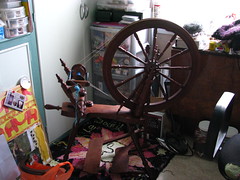On the other hand, using a wheel means that you can spin faster and I find that I can spin for longer if the music/chat/film is good. The main drawback with a wheel is that many of them are not terribly portable.
All that aside, the technique of drafting remains the same once you have mastered the treadle.
My first experience with a wheel was at a visit to the local Weavers Spinner and Dyer's guild where they gave me some tuition and lent me a wheel (Ashford Traditional) to practice on,
I then borrowed a different style wheel (Ashford Traveller) from them to see which I preferred.

In the meantime I had chance to visit a summer school open day and was able to try out a few different wheels and fell madly in love with the Kromski Sonata which I could not afford but I was determined to start saving up as soon as possible.
A friend kindly gave me a wheel which has had a great deal of use over the last year or so and I did eventually buy a secondhand Sonata and that is the wheel that I generally take out with me.


The whole process of spinning and dying your own yarn is amazing as the the fibre/yarn/finished article all produce different effects.
This is some shetland fibre, dyed with acid dyes, spun and knitted into a small shawl .
Whilst this shetland was left undyed and knitted up as a two ply.
Of course there is no reason why you shouldn't be adventurous and add beads to your spinning, vary the thickness of the yarn and generally have a bit of fun.

Any questions, ask at the shop for details of our spindle workshop or look out for strange people with spinning wheels in pubs and cafes around Nottingham...more about spinnotts in a later post.
Guzzisue





No comments:
Post a Comment